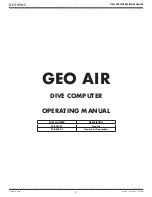Pyrocam IV Oper
ator’s Manual
Document No. 50337-001
Rev F
2/21/2017
Page 18
In mode 2 and 3 the Pyrocam firmware measures the trigger pulse period and predicts
when the next pulse will occur. Based on the predicted trigger time, the exposure start
time can be advanced (made early). When a negative
Delay
is entered, the exposure
time will start early based on the negative
Delay
value. This early exposure start time
will compensate for lasers that fire at or before the trigger pulse’s arrival at the Pyrocam.
It can also compensate for pulse to pulse jitter when the pulse rate is less stable.
For lasers with very short pulse times (10µs or less) that start at the triggers rising edge,
some amount of negative
Delay
is required to capture the pulse. Without it, the pulse
will occur prior to the exposure window being able to open.
Hint:
For laser pulses that occur simultaneous with the trigger rising edge and are shorter
than 100µs, set the
Delay
time to -50µs and set the
Exposure
time to the pulse
width plus 70µs.
NOTE:
Calibrating the Pyrocam with a slow pulse rate in mode 2 will take a while to
complete, so be patient
.
Figure 3.2 : Mode 2, Periodic,
𝟑𝑯𝒛 < 𝒇
𝒕𝒓𝒊𝒈
< 𝒇
𝒎𝒂𝒙
𝑓
𝑚𝑎𝑥
= (8.705𝑚𝑠 + 𝑇
𝐸
)
−1
𝑻
𝑫
= −(𝑻
𝒕𝒋
+ 𝟏𝟎)
𝑇
𝐸
= |𝑇
𝐷
| + 𝑇
𝑙𝑤
+ 20
for
𝑇
𝑙𝑤
< 100
𝑇
𝐸
= 𝑇
𝑡𝑗
+ 1.15 𝑇
𝑙𝑤
for
𝑇
𝑙𝑤
≥ 100
3.3.5
Mode 2, Periodic-Burst Operation
The
Delay
timer can be used to capture (split-out) a single laser pulse from a burst of
pulses.
demonstrates this timing for a periodic burst event; however this
same scheme can be used for a single shot burst event. The
Delay
time needs to expire
just a few tens of µs before the pulse to be captured, and the
Exposure
time to end


















